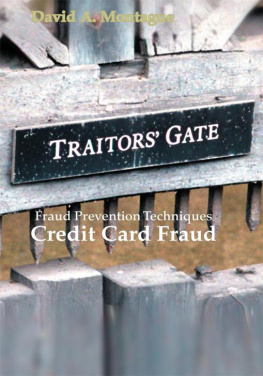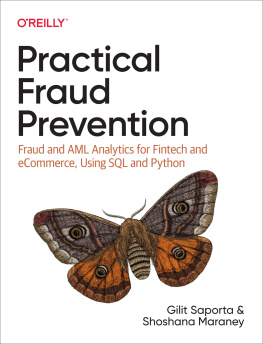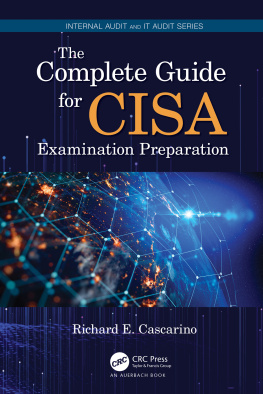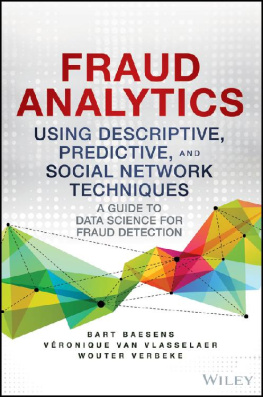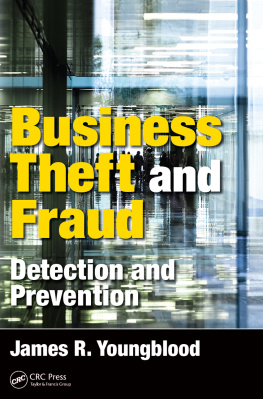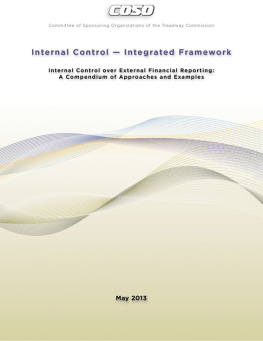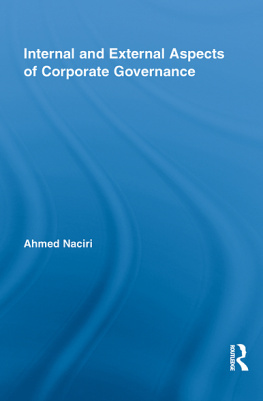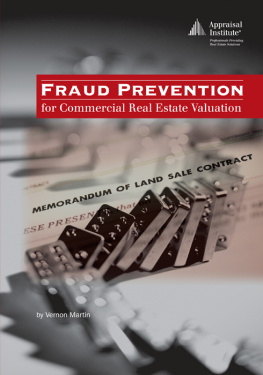Cascarino - Corporate fraud and internal control: a framework for prevention
Here you can read online Cascarino - Corporate fraud and internal control: a framework for prevention full text of the book (entire story) in english for free. Download pdf and epub, get meaning, cover and reviews about this ebook. City: Hoboken;N.J, year: 2013;2012, publisher: John Wiley & Sons, genre: Romance novel. Description of the work, (preface) as well as reviews are available. Best literature library LitArk.com created for fans of good reading and offers a wide selection of genres:
Romance novel
Science fiction
Adventure
Detective
Science
History
Home and family
Prose
Art
Politics
Computer
Non-fiction
Religion
Business
Children
Humor
Choose a favorite category and find really read worthwhile books. Enjoy immersion in the world of imagination, feel the emotions of the characters or learn something new for yourself, make an fascinating discovery.

- Book:Corporate fraud and internal control: a framework for prevention
- Author:
- Publisher:John Wiley & Sons
- Genre:
- Year:2013;2012
- City:Hoboken;N.J
- Rating:4 / 5
- Favourites:Add to favourites
- Your mark:
- 80
- 1
- 2
- 3
- 4
- 5
Corporate fraud and internal control: a framework for prevention: summary, description and annotation
We offer to read an annotation, description, summary or preface (depends on what the author of the book "Corporate fraud and internal control: a framework for prevention" wrote himself). If you haven't found the necessary information about the book — write in the comments, we will try to find it.
Cascarino: author's other books
Who wrote Corporate fraud and internal control: a framework for prevention? Find out the surname, the name of the author of the book and a list of all author's works by series.
Corporate fraud and internal control: a framework for prevention — read online for free the complete book (whole text) full work
Below is the text of the book, divided by pages. System saving the place of the last page read, allows you to conveniently read the book "Corporate fraud and internal control: a framework for prevention" online for free, without having to search again every time where you left off. Put a bookmark, and you can go to the page where you finished reading at any time.
Font size:
Interval:
Bookmark:
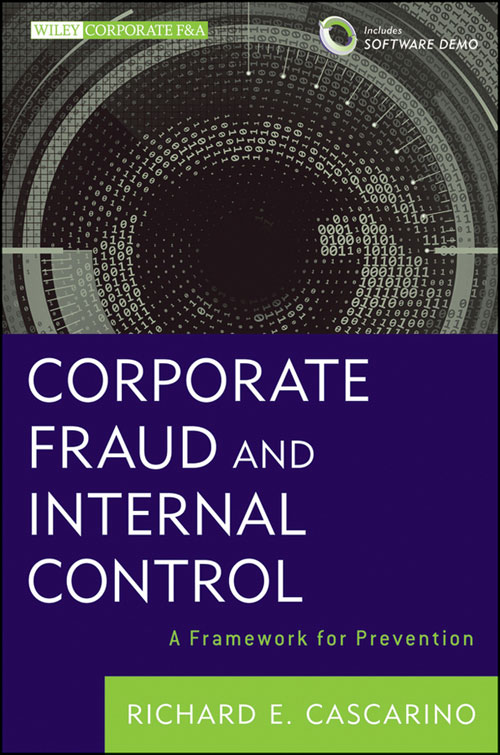

Copyright 2013 by Richard E. Cascarino. All rights reserved.
Published by John Wiley & Sons, Inc., Hoboken, New Jersey.
Published simultaneously in Canada.
No part of this publication may be reproduced, stored in a retrieval system, or transmitted in any form or by any means, electronic, mechanical, photocopying, recording, scanning, or otherwise, except as permitted under Section 107 or 108 of the 1976 United States Copyright Act, without either the prior written permission of the Publisher, or authorization through payment of the appropriate per-copy fee to the Copyright Clearance Center, Inc., 222 Rosewood Drive, Danvers, MA 01923, (978) 750-8400, fax (978) 646-8600, or on the Web at www.copyright.com . Requests to the Publisher for permission should be addressed to the Permissions Department, John Wiley & Sons, Inc., 111 River Street, Hoboken, NJ 07030, (201) 748-6011, fax (201) 748-6008, or online at http://www.wiley.com/go/permissions .
Limit of Liability/Disclaimer of Warranty: While the publisher and author have used their best efforts in preparing this book, they make no representations or warranties with respect to the accuracy or completeness of the contents of this book and specifically disclaim any implied warranties of merchantability or fitness for a particular purpose. No warranty may be created or extended by sales representatives or written sales materials. The advice and strategies contained herein may not be suitable for your situation. You should consult with a professional where appropriate. Neither the publisher nor author shall be liable for any loss of profit or any other commercial damages, including but not limited to special, incidental, consequential, or other damages.
For general information on our other products and services or for technical support, please contact our Customer Care Department within the United States at (800) 762-2974, outside the United States at (317) 572-3993 or fax (317) 572-4002.
Wiley also publishes its books in a variety of electronic formats. Some content that appears in print may not be available in electronic books. For more information about Wiley products, visit our web site at www.wiley.com .
Library of Congress Cataloging-in-Publication Data
Cascarino, Richard.
Corporate fraud and internal control : a framework for prevention/Richard E. Cascarino.
p. cm.(The Wiley corporate F&A series)
Includes bibliographical references and index.
ISBN 978-1-118-30156-2 (cloth); ISBN 978-1-118-41980-9 (ebk);
ISBN 978-1-118-42172-7 (ebk);ISBN (eMobi) 978-1-118-43402-4 (ebk)
1. FraudPrevention. 2. Auditing, Internal. I. Title.
HV6691.C38 2013
658.473dc23
2012022692
Preface
DATING BACK TO 3500 BC, records of various civilizations indicate by patterns of checks and ticks that record verification took place. In ancient Egyptian, Greek, Chinese, and Roman civilizations, rulers sought to confirm official records by comparing two sets of such records. The lowest-ranking magistrate in ancient Rome was a quaestor , or investigator. This elected official traditionally worked within the treasury to supervise the financial affairs of the empire.
Accuracy of records was tested, typically by two officials working together. One official read from the one record sheet and the other checked against the other record sheet. The term auditor is derived from the Latin auditus , meaning a hearing.
With the fall of the Roman Empire, auditing and internal control disappeared in Europe. It was not until the Middle Ages that the growth of centralized control once again demanded proof of the adequacy and correctness of record keeping and the prevention of the defrauding of the king.
In the Orient, however, audit can trace its ancestry back to the Western Zhou Dynasty some 3000 years ago, in which it continued in various forms until the Song Dynasty in 992AD when a royal audit court was established. Audit in China took the form of Inspectorates until the Revolution of 1911 when an Audit Court was established, a Chamber of Audit set up, and Audit Law was issued. Auditing continued until the founding of the Peoples Republic of China in 1949 when audit was conducted by internal supervision within the Departments of Public Finance.
In 1982, the Constitution of the Peoples Republic of China was promulgated resulting in the 1983 formation of the National Audit Office of the Peoples Republic of China.
Today, capital markets, which have been rocked by recent corporate scandals and frauds on an international scale, are demanding that financial organizations, publicly listed companies, multinational companies, and the public sector implement sound corporate governance. Large-scale fraud has severely eroded investor confidence; in many cases, investors are simply waiting for the next large fraud to be announced.
In the past, many organizations, companies, and government bodies have operated in a purely reactive mode to the problem of fraud. That is, only after a fraud had taken place were decisions made regarding how to combat it. With the increasing impact of corporate governance legislation and the changes in society of recent years, the need to fight fraud in a proactive manner has become paramount.
Companies now must accept their corporate responsibility to protect assets and employees from the temptations and impacts of fraud.
At the individual level, fraud is impacting every citizen, either directly through being defrauded or indirectly through the impact of higher taxation or shopping bills. Individual fraud is also creating an atmosphere in which individuals feel cheated and defrauded, and that they have the right to retaliate by cheating and defrauding others.
Police services are under increasing pressure to combat all types of crime, particularly violent crime. As a result, often white-collar crime, corruption, and fraud are treated as the poor relation at the low end of the resources chain and receive priority only in egregious cases when they become front-page news in the newspapers.
As a result, organizations have no choice but to develop plans and strategies to deter, detect, and, where required, prove fraud utilizing their own in-house control mechanisms and systems of internal control.
This book addresses the roles of the board and its management and audit committees in implementing a system of internal controls that adequately defends against fraudulent and corrupt practices both within the organization and against it. The book itself consists of 12 chapters.
Chapter 1, Nature of Fraud, introduces fraud and irregularities, covering the elements of the crimes of theft and fraud as well as the nature and cost of fraud. It includes the basics of fraud and financial irregularities and defines fraud and prejudice resulting from fraud. It also presents general safeguards to make fraud in commerce more difficult, and ways to seek redress from fraud perpetrators.
Chapter 2, Elements of the Crimes of Theft and Fraud, explores how fraud and conventional theft differ legally. It also helps identify the principal control elements required to reduce the likelihood of a fraud occurring and its impact, should it occur, and to increase the probability of early detection in the event of an occurrence.
Chapter 3, Frauds Against the Individual, identifies specific types of fraud against the individual that, left unchecked, may increase the probability of a loyal employee turning against the employer in desperation. It also identifies corporate responsibility in educating employees against potential fraud attacks against them personally.
Next pageFont size:
Interval:
Bookmark:
Similar books «Corporate fraud and internal control: a framework for prevention»
Look at similar books to Corporate fraud and internal control: a framework for prevention. We have selected literature similar in name and meaning in the hope of providing readers with more options to find new, interesting, not yet read works.
Discussion, reviews of the book Corporate fraud and internal control: a framework for prevention and just readers' own opinions. Leave your comments, write what you think about the work, its meaning or the main characters. Specify what exactly you liked and what you didn't like, and why you think so.

